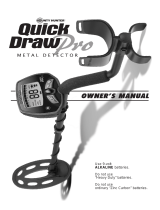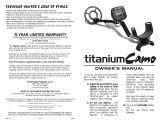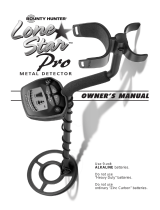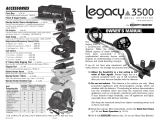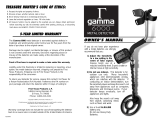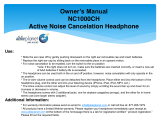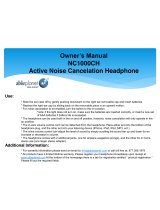Page is loading ...

OWNER’S MANUAL
Use 9-volt
ALKALINE batteries.
Do not use
“Heavy Duty” batteries.
Do not use
ordinary “Zinc Carbon” batteries.

2
TABLE OF CONTENTS
Congratulations!
Congratulations on the purchase of your new Bounty Hunter
®
Quick Draw
®
Pro
Metal Detector. The Quick Draw Pro is the result of nine years of software
engineering and features the latest advancements in lightweight design, target
accuracy and deep-penetrating detection technology.
The Quick Draw Pro can be used with its default turn-on-and-go settings, or it
can be programmed to your specific treasure hunting goals and objectives or
desired settings. Treasure hunting enthusiasts from around the world were
involved in the development of this revolutionary new detector. This manual
has been written to help you get optimal use of your detector so we hope you
will read it thoroughly before your first outing.
Happy Hunting from First Texas Products!
Terminology . . . . . . . . . . . . . . . . . . . . . . . . . . . . . . . . . . . . . . . . . . . . . . . . . . . . . . . . .3
Contents . . . . . . . . . . . . . . . . . . . . . . . . . . . . . . . . . . . . . . . . . . . . . . . . . . . . . . . . . . .4
Assembly . . . . . . . . . . . . . . . . . . . . . . . . . . . . . . . . . . . . . . . . . . . . . . . . . . . . . . . . . . .5
Batteries (use alkaline batteries) . . . . . . . . . . . . . . . . . . . . . . . . . . . . . . . . . . . . . . . .6
Quick-Start Demonstration . . . . . . . . . . . . . . . . . . . . . . . . . . . . . . . . . . . . . . . . . . . . .7
The Basics of Metal Detecting . . . . . . . . . . . . . . . . . . . . . . . . . . . . . . . . . . . . . . . .8-9
How to Work the Controls . . . . . . . . . . . . . . . . . . . . . . . . . . . . . . . . . . . . . . . . . . . . . .9
The Display . . . . . . . . . . . . . . . . . . . . . . . . . . . . . . . . . . . . . . . . . . . . . . . . . . . . . . . .10
Menu . . . . . . . . . . . . . . . . . . . . . . . . . . . . . . . . . . . . . . . . . . . . . . . . . . . . . . . . . .11-12
Sensitivity . . . . . . . . . . . . . . . . . . . . . . . . . . . . . . . . . . . . . . . . . . . . . . . . . . . . . .11
Volume . . . . . . . . . . . . . . . . . . . . . . . . . . . . . . . . . . . . . . . . . . . . . . . . . . . . . . . .11
Discrimination . . . . . . . . . . . . . . . . . . . . . . . . . . . . . . . . . . . . . . . . . . . . . . . . . . .11
Notch . . . . . . . . . . . . . . . . . . . . . . . . . . . . . . . . . . . . . . . . . . . . . . . . . . . . . . . . .12
Pinpoint . . . . . . . . . . . . . . . . . . . . . . . . . . . . . . . . . . . . . . . . . . . . . . . . . . . . . . . . . . .13
Target Identification . . . . . . . . . . . . . . . . . . . . . . . . . . . . . . . . . . . . . . . . . . . . . . . . .14
Depth and Target Display . . . . . . . . . . . . . . . . . . . . . . . . . . . . . . . . . . . . . . . . . . . . .15
Using the detector . . . . . . . . . . . . . . . . . . . . . . . . . . . . . . . . . . . . . . . . . . . . . . . . . . .16
Characteristics & Limitations . . . . . . . . . . . . . . . . . . . . . . . . . . . . . . . . . . . . . . . . . .17
Troubleshooting . . . . . . . . . . . . . . . . . . . . . . . . . . . . . . . . . . . . . . . . . . . . . . . . . . . .18
Treasure Hunter's Code of Ethics . . . . . . . . . . . . . . . . . . . . . . . . . . . . . . . . . . . . . .19
Warranty . . . . . . . . . . . . . . . . . . . . . . . . . . . . . . . . . . . . . . . . . . . . . . . . . . . . . . . . . .19
Accessories . . . . . . . . . . . . . . . . . . . . . . . . . . . . . . . . . . . . . . . . . . . . . . . . . . . . . . .20

TERMINOLOGY
The following terms are used throughout the manual, and are standard
terminology among detectorists.
RELIC
A relic is an object of interest by reason of its age or its association with
the past. Many relics are made of iron, but can also be made of bronze
or precious metals.
IRON
Iron is a common, low-grade metal that is an undesirable target in certain
metal detecting applications. Examples of undesirable iron objects are old
cans, pipes, bolts and nails.
Sometimes, the desired target is made of iron. Property markers, for
instance, contain iron. Valuable relics can also be composed of iron;
cannon balls, old armaments and parts of old structures and vehicles can
also be composed of iron.
FERROUS
Metals which are made of, or contain, iron.
ELIMINATION
Reference to a metal being "eliminated" means that the detector will not
emit a tone, nor display a Target-ID, when a metal object passes through
the searchcoil's detection field.
DISCRIMINATION
When the detector emits different tones for different types of metals, and
when the detector "eliminates" certain metals, we refer to this as the
detector "discriminating" among different types of metals.
Discrimination is an important feature of professional metal detectors.
Discrimination allows the user to ignore trash and otherwise undesirable
objects.
PINPOINTING
Pinpointing is the process of finding the exact location of a buried object.
Long-buried metals can appear exactly like the surrounding soil, and can
therefore be very hard to isolate from the soil.
GROUND CANCELATION
Ground Cancelation is the ability of the detector to ignore, or "see through,"
the earth's naturally occurring minerals, and only sound a tone when a
metal object is detected. This detector incorporates proprietary circuitry to
eliminate false signals from many mineralized soils.
3

CONTENTS OF BOX
The following detector components are in the box:
1. S-ROD with Control Housing, Arm Rest and Locking Collar
2. Lower Stem
3. Searchcoil
4. Bolt & Knurled Knob
5. This Owner's Manual
4

5
ASSEMBLING THE DETECTOR
Hand-grip
Searchcoil
Cable
Cable
Plug
S-Rod
Locking
Collar
Battery
Compartment
(back side)
Headphone
Jack
Armrest
Searchcoi
l
Slack
in cable
Hold S-ROD upright.
Loosen LOCKING COLLAR on S-ROD;
rotate counterclockwise.
Insert LOWER STEM into S-ROD with the
SILVER BUTTON pointed upward.
Rotate the LOWER STEM until the
SILVER BUTTON locates and clicks into
a hole.
Attach the SEARCHCOIL to the LOWER
STEM using the BOLT and KNURLED
KNOB.
Adjust the LOWER STEM to a length that
lets you maintain a comfortable upright
posture while holding the detector relaxed
at your side with the SEARCHCOIL
parallel to the ground in front of you.
Wind the CABLE around the STEM.
Leave slack in the cable at the bottom to
allow the searchcoil to pivot.
Align the pins on the CABLE PLUG to the
connector holes on the rear of the control
housing.
Push in CABLE PLUG.
쐅
Twist the LOCKING COLLAR fully in the
clockwise direction until stems are locked
securely together.
S-ROD
LOCKING
COLLAR
INTERNAL
CAM LOCK
SILVE R BUTTON
LOWER
STEM
S-ROD
LOWER STEM

The detector requires a single 9-volt ALKALINE battery (battery not included).
Do not use ordinary “Zinc Carbon” batteries
Do not use “Heavy Duty” batteries.
Rechargeable batteries can also be used. If you use rechargeables, we
recommend using a “Nickel Metal Hydride” rechargeable battery.
The battery compartment is located on the back side of the Control Housing.
Slide the battery door to the side to remove. Insert battery. Close battery door.
When it's time to replace the battery simply push down firmly on the bottom of
the battery (see illustration).
BATTERY LIFE
Expect 20 to 25 hours of life from a
9-volt alkaline battery.
Rechargeable batteries provide about 8
hours of usage per charge.
BATTERY INDICATOR
The battery icon has three segments
plus an outline segment.
The amount of battery voltage for an
ALKALINE battery is indicated as
follows:
3 segments illuminated: 8.1 volts or more
2 segments illuminated: 7.1 to 8.0 volts
1 segment illuminated: 6.5 to 7.0 volts
No segments illuminated: 6.2 to 6.4 volts
Outline Flashing: 6.1 or less
SPEAKER VOLUME AND BATTERY CHARGE
You may notice the speaker volume drop while one battery segment is
illuminated.
With the outline flashing, low speaker volume will be very apparent.
BATTERY DISPOSAL & RECYCLING
Alkaline batteries may be disposed of in a normal waste receptacle or recycled.
Non-Alkaline batteries should be recycled. In the state of California all battery
types must be recycled. Please refer to local municipalities for detailed disposal
and recycling requirements.
6
BATTERIES
BATTERY
REMOVAL
Patent Pending
15
DEPTH AND TARGET DISPLAY

I. Supplies Needed:
a Nail (made of iron) a U.S. Quarter (or silver coin)
a U.S. Nickel a Gold Ring
a U.S. Dime a U.S. Penny, dated after 1982 (post-1982
pennies are made of Zinc)
(Most newer non-U.S. coinage also contains mostly Zinc)
II. Position the Detector:
a.Place the detector on a table with the searchcoil hanging over the edge. Or
better, have a friend hold the detector with the searchcoil off the ground.
b.Keep the searchcoil away from walls,
floors and metal objects.
c. Remove watches, rings and jewelry.
d.Turn off lights or appliances whose
electromagnetic emissions may cause
interference.
e.Pivot the searchcoil back.
f. Press to power on.
III. Demonstrate DISCRIMINATION Feature:
a.Pass all objects over the searchcoil and notice the different tones.
Nail: low tone
Nickel: medium tone
Zinc Penny: medium tone
Gold Ring: most gold rings will register with a medium tone
Dime: high tone
Quarter: high tone
b.Press until DISC is highlighted on the display.
7
QUICK-START DEMONSTRATION
c. Press once. The iron indicator on the display will disappear.
d.Wave the nail. It will not be detected because it has been
“discriminated out.”
IV. Demonstrate NOTCH Feature:
a.Press until NOTCH is highlighted.
b.Press four times. The “Zn” icon will flash and then disappear.
c. Wave a Zinc Penny over the searchcoil. It will not be detected because it
has been “notched out.” Notice on the display the target categories not
illuminated are not detected.
V. Demonstrate PINPOINT Feature:
a.Press and hold . “PP” momentarily appears on the screen.
b.Hold a coin motionless over the searchcoil.
c. Lower coin toward searchcoil and then raise coin away from searchcoil.
d.Notice that the sound changes as the coin moves closer and farther.
e.Notice that the depth indicator changes as the coin moves up and down.

This metal detector is intended for locating buried metal objects. When
searching for metals, underground or on the surface, you have the following
challenges and objectives:
1. Ignoring signals caused by ground minerals.
2. Ignoring signals caused by metal objects that you do not want
to find, like nails.
3. Identifying a buried metal object before you dig it up.
4. Estimating the size and depth of objects, to facilitate digging them up.
5. Eliminating the effects of electromagnetic interference from other
electronic devices.
Your metal detector is designed with these things in mind.
1. Ground Minerals
All soils contain minerals. Signals from ground minerals can interfere with
the signals from metal objects you want to find. All soils differ, and can differ
greatly, in the type and amount of ground minerals present. This detector
has proprietary circuitry to automatically eliminate interfering signals from
minerals that occur naturally in the ground.
NOTE: This detector will not completely eliminate interference from all types
of minerals. For example, the detector IS NOT designed for use on wet
sand saltwater beaches. Another example of soil this detector will not
eliminate is any soil containing large concentrations of iron oxides, which are
usually red in color.
2. Trash
If searching for coins, you want to ignore items like aluminum foil and nails.
You can see the Target-ID value of the buried objects, listen to the sounds
and then decide what you want to dig up. Or you can eliminate unwanted
metals from detection by using the DISCRIMINATION feature.
3. Identifying Buried Objects
Metal objects are identified along the 9-segment Conductivity Arc. This scale is an
indicator of the relative electrical conductivity of different objects. Segments to the
right indicate more conductive targets. Iron objects, which are usually of lesser
value, illuminate on the left-most segments. Silver objects illuminate on the right-
most segments.
4. Size and Depth of Buried Objects
The 3-segment graphic indicates the relative depth of a buried metal object.
This graphic can indicate the relative size of different objects or their distance from
the searchcoil. For a given object, the more distance between it and the searchcoil,
the more arrows illuminated.
8
THE BASICS OF METAL DETECTING

5. EMI (Electromagnetic Interference)
The searchcoil produces a magnetic field and then detects changes in that
magnetic field caused by the presence of metal objects. This magnetic
field that the detector creates is also susceptible to the electromagnetic
energy produced by other electronic devices. Cell phones, cell phone
towers, power lines, microwave ovens, lighting fixtures, TVs, computers,
motors, etc… all produce EMI which can interfere with the detector and
cause it to beep when no metal is present, and sometimes to beep
erratically.
The SENSITIVITY control lets you reduce the strength of this magnetic
field, and therefore lessen its susceptibility to EMI. You may want to
operate at maximum strength, but the presence of EMI may make this
impossible, so if you experience erratic behavior or “false” signals, reduce
the sensitivity.
THE BASICS OF METAL DETECTING
9
POWER
ON/OFF
Press
-
or
+
to
CHANGE THE
SETTING of
the active
menu item
Press-and-Hold
PINPOINT for
precision target
pinpointing
at any time
Press MENU to
make it active.
The current
selection is
indicated
with a “
•
”
HOW TO WORK THE CONTROLS

10
THE DISPLAY
POWER
ON/OFF
Target
Category
Icons
Menu
Target-ID
Target
Depth
Indicator
Battery Level
Indicator
Target Conductivity Arc
(Metal objects are classified by electrical conductivity,
the highest to the right)
DEPTH INDICATOR
Coin-sized objects will be detected up to 9” deep.
The 3-segment graphic indicator is calibrated to coin-sized objects.
Coin on Surface Coin is Shallow Coin is Very Deep
Objects other than coins will still register on the 3-segment depth scale, but the
depth indication will be relative. For example, all 3 segments illuminated could
indicate a coin buried 9” deep, but could also be a very large object several feet
deep. Use the Depth Indicator in conjunction with the Conductivity Arc to gain
more information.
OVERLOAD WARNING
If a metal object or highly magnetic soil are too close to the searchcoil, the
detector will overload and “
--
” will appear on the screen. The detector will
make a rapid, repeating mid-tone warning sound. Overload will not harm the
detector, but the detector will not function under these conditions. If overload
occurs, raise the searchcoil to detect the target from a greater distance, or
move to a different location.

11
The Menu is located on the left side of the screen. During normal operation the
Menu is inactive and faded. Press the MENU button to cycle through the
Menu. Each press of the Menu button moves to the next Menu item.
Use and to select a Menu option. The option selected is marked by “
•
”.
Once a menu option is selected, the setting can be changed using
and . Here is a description of the Menu options:
SENS
Adjust the sensitivity from 1 to 10. The higher the number, the more sensitive
the detector. This sensitivity control does not affect Pinpoint sensitivity.
If the detector beeps erratically or beeps when there are no metal objects being
detected, reduce the sensitivity.
The searchcoil produces a magnetic field and then detects changes in that
magnetic field caused by the presence of metal objects. This magnetic field
that the detector creates is also susceptible to electromagnetic energy (EMI)
produced by other electronic devices. Cell phones, cell phone towers, etc…
all produce EMI which can interfere with the detector and cause it to beep
when no metal is present, and sometimes to beep erratically.
VOLUME
Adjust speaker volume from 0 to 10. The Volume control changes the
loudness of the audio when targets are detected, and also the loudness of
the keypad presses and warning sounds.
DISC
DISCRIMINATION
When the detector emits different tones for different types of metals, and
when the detector "eliminates" certain metals, we refer to this as the detector
"discriminating" among different types of metals.
Discrimination is an important feature of professional metal detectors.
Discrimination allows the user to ignore trash and otherwise undesirable
objects.
The DISC controls the detector's Discrimination function. In its default setting
all metals are detected. Use this
DISC
control in order to eliminate
unwanted types of metals from detection. Targets are eliminated from
detection from left to right across the Target Category Arc.
Each time you press the key a target category icon will disappear.
When an icon disappears that category is eliminated from detection. Notice
that the 4 right-most categories cannot be eliminated. These 4 right-most
categories represent silver or other high-value targets, which are generally
desirable; therefore the detector does not allow them to be discriminated out.
To return categories to detection, press the key and categories will be
accepted back for detection from right to left.
MENU

12
MENU
NOTCH
The
NOTCH
control is similar to Discrimination in that it allows you to accept
or reject different types of metals. While DISC works left to right, the NOTCH
control allows you to accept or reject individual categories.
Categories eligible for NOTCH are
FOIL
,
5¢
, ALUM, Zn.
Press or to program the NOTCH feature. Each press of
or cycles to a new category and that category icon will flash for
3 seconds. Then the category will reverse status. Alternatively, press
while the icon is flashing to accept the Notch. If the icon had previously
been illuminated it will now disappear indicating that the category has
been eliminated from detection. Likewise, an icon that is not visible on the
display will re-illuminate, indicating that that category is now notched in
(i.e. detected).
Use or to select
NOTCH
. Each time you press or
the category to be notched flashes on the screen. Any of the 4 eligible
categories can be “Notched” in or out. After the category icon flashes
and times out, the Notch status will change.

13
Press-and-hold to activate the Pinpoint feature.
Searchcoil motion is not required; a motionless searchcoil over a metal target
will induce sound.
Audio is V.C.O. The 2-digit number displayed indicates target depth, in inches.
The scale in calibrated to coin-sized objects.
How to Pinpoint
After you have identified a target, press-and-hold to identify the target's
exact location. This technique can yield more information about the target's
shape and size and also find its exact location to facilitate extraction.
Pinpoint as follows:
1. Press and hold
.
2. Position the searchcoil just barely off the ground, and to the side of the
target.
3. Now move the searchcoil slowly across the target, and you can locate it
by the sound.
The target is located directly under where the sound is loudest.
Narrow It Down:
1. To narrow the response further, position the center of the searchcoil near
the center of the response pattern, but not directly over the center.
2. Release .
PINPOINT
3. Immediately press-and-hold again.
4. Repeat this narrowing procedure to narrow the field of detection further.
Note: Depth indication is less accurate after narrowing.
COIL DRIFT
If you plan to use PINPOINT for continuous searching, realize that drift will
occur over time, causing the detector to gain or lose sensitivity. Periodic
retuning of the detector is required to minimize drift; release and press
periodically to retune.
Pinpointing using motion modes (without ):
1. Sweep over target in narrowing side-to-side patterns.
2. Take note of the spot on the ground where “beep” occurs.
3. Step 90° to the side of the target.
4. Sweep searchcoil over.
5. This pinpoints the target location with an “X”.

14
The faceplate label is color-coded above the Conductivity Arc. Ferrous, gold and
silver targets will generally register within their corresponding color-coded
ranges. Targets that are not gold or silver register within the same range
according to their electrical conductivity.
Note that the electrical conductivity of a target depends on both its composition
and size. Silver is more conductive than gold so it registers farther to the right;
the larger the silver object, the farther it registers to the right.
Target-ID
When objects are detected, the detector will emit a sound and a 2-digit Target-ID
will appear on the screen. Possible Target-IDs range from 1 to 99. This number
represents the electrical conductivity of the target; higher numbers indicate more
highly conductive targets.
The 2-digit number indicates the Target-ID of the last object detected. This detector
has fast target response and is able to detect different objects in very close
proximity. Therefore, the Target-ID displayed may change rapidly as you sweep the
searchcoil.
Three seconds after the last Target-ID is displayed, the Target-ID will time-out and
the number will disappear.
At the same time the 2-digit Target-ID appears an indicator will illuminate along the
Target Category Arc indicating which target category the detected metal object falls
into. The segment at the top will time out in 3 seconds along with the Target-ID.
3-Tone Target Identification
The detector will provide 1 of 3 sounds for any metal object detected: a low,
medium or high tone. This audio feedback system is useful in conjunction with
the visual Target-ID system described above.
TARGET IDENTIFICATION

15
DEPTH AND TARGET DISPLAY
Please refer to the display on your
detector and reference the TARGET-ID
categories below applicable to your
model (not all detectors include all of
these categories).
READING THE DISPLAY
The display shows the PROBABLE
identification of the metal detected, as well
its PROBABLE depth.
The detector will register a target
identification, upon each sweep of the
searchcoil, when a buried target has been
located and identified. If, upon repeated
passes over the same spot, the target
identification reads inconsistently, the
target is probably a trash item. With
practice, you will learn to unearth only the
repeatable signals.
The segment identifications are highly
accurate, when detecting the objects
described on the faceplate. However, if an
object registers in a given category for an
unknown buried object, you could be
detecting a metallic object other than the
object described on the faceplate, but with
the same metallic signature. Also, the
greater the distance between the target
and the searchcoil, the less accurate the
target identification.
GOLD TARGETS
Gold objects will
generally register toward the middle or
left-of-center on the scale.
Gold flakes will register under iron.
Small gold items will register under foil
or 5¢.
Large gold items will register toward the
center of the scale.
SILVER TARGETS:
Silver objects will
register to the right of the scale, under
dime or higher.
IRON:
All sizes of iron objects will
register on the far-left side of the scale.
This could indicate a worthless item such
as a nail, or a more valuable historic iron
relic.
FOIL:
Aluminum foil, such as a gum
wrapper, will register as foil. A small
broken piece of pull tab may also register
here.
5¢
: Most newer pull-tabs from beverage
cans, the type intended to stay attached
to the can, will register here. Many gold
rings will also register here.
ALUM: Older pull-tabs, which always
detached completely from the can, register
here. Many medium-sized gold rings also
register here.
PT (pull-tabs): Pull-tabs from older
beverage cans will register here. Few
newer pull-tabs will also register here.
Many gold rings will also register here.
S-CAP: Older screw caps from glass
bottles will register here. Large gold rings,
like a class ring, could also register here.
Some non-U.S. coins of recent vintage
will also register here.
Zinc: Medium conductivity objects and
many non-U.S. coins of recent vintage are
classified here.
The Target Identification Categories to the
right of the display, such as 10¢, DIME,
25¢, Quarter, 50¢ and $1 accurately
identify these U.S. coins. When used in
areas outside the U.S., these categories
identify coins or metal objects of high
relative conductivity (such as silver coins
or relics), or large objects made of any
type of metal.
Caution: The target indications are
visual references. Many other types of
metal can fall under any one of these
categories. While the detector will
eliminate or indicate the presence of most
common trash items, it is impossible to
accurately classify ALL buried objects.

16
HEADPHONE JACK
This detector has a 1/4” headphone
jack. It works with any stereo
headphone that has a 1/4” plug.
When the headphone jack is
connected, speaker volume is
disabled.
USING HEADPHONES
Using a detector with headphones
facilitates detection of the weakest
signals and also extends battery life.
It also allows you to hear subtle
changes in the sound more clearly,
particularly if searching in a noisy
location. For safety reasons, do not
use headphones near traffic or where other dangers are present. This device
is to be used with interconnecting cables/headphone cables shorter than three
meters.
Sweep Method
Sweep the detector side-to-side over
the ground.
Keep the searchcoil parallel to the
ground as you sweep; do not lift the
searchcoil at the ends of your sweeps.
Searchcoil motion is required for target
detection (except when using Pinpoint).
CORRECT
WRONG
USING THE DETECTOR

17
1. This detector comes with a waterproof searchcoil. The searchcoil can be
completely submerged into water. The control housing is not waterproof
and cannot be submerged in water. To use the detector in inclement
weather, consider purchasing the optional detector cover.
2. BURIED UTILITY LINES. This hobby metal detector is not designed to
locate buried pipes or cables
. First Texas Products manufactures a
complete line of pipe and cable locators for this application. These are
sophisticated instruments with functionality different from your hobby metal
detector.
3. SEVERE SOIL CONDITIONS. While this detector has proprietary circuitry
to cancel out minerals naturally occurring in most soil types, it cannot
penetrate the most severe soils and it is not intended for use on wet
sand saltwater beaches. However, it is well-suited for detecting on dry
sand. Saltwater is highly conductive and requires a more sophisticated
type of detector. First Texas Products offers such types of detectors. Other
highly mineralized soils, such as those found in some gold prospecting
sites, may also limit this detector's capability. If the detector tends to
overload it could indicate you are in an area containing such severe soils.
4. TARGET-ID. The detector's Target-ID system calculates and displays the
most probably identification. Target-ID is affected by soil conditions, the
searchcoil's distance from the target, the length of time the target has been
buried and the target's proximity to other dissimilar targets. Very large
metal objects can overload the detector and may be classified
inaccurately.
5. REDUCE SENSITIVITY. The primary purpose of the Sensitivity control is
to allow the operator to reduce the sensitivity
of the detector. All
detectorists desire to find objects at maximum depth. However, in today's
environment there is a never ending variety of devices emitting EMI
(Electromagnetic Interference) that can interfere with this detector.
There will be environments where the detector cannot operate at
maximum sensitivity. This is not a defect. If you find yourself in such an
environment, reduce the sensitivity of the detector. Some environments
may have so much EMI it is impossible to detect there. Both overhead
power lines and buried power lines can interfere with this detector. Power
line capacity may be quite different during certain times of the day. For
instance, peak hours of electrical use that can occur around 6 p.m. can
lead to a lot of EMI. If you experience power line interference, try returning
to a given area at a different time of day.
CHARACTERISTICS & LIMITATIONS

18
TROUBLESHOOTING GUIDE
SYMPTOM CAUSE SOLUTION
Detector chatters, • Using detector • Use detector
beeps erratically indoors outdoors only
or has low • Using detector near • Move away
sensitivity power lines
from power lines
• Using 2 detectors in • Keep 2 detectors
close proximity at least 6 meters
(20’) apart
• Environmental • Reduce sensitivity
electromagnetic until erratic
interference signals cease
Low speaker •
Discharged battery
• Replace battery
volume
• Wrong type of • Use alkaline
battery batteries
Display does not lock
• Multiple targets •
Sweep coil at
on to one Target-ID present different angles
or detector emits • Highly mineralized • Move to a
multiple tones soil different area
• Sensitivity set
too high • Reduce sensitivity
No power, no sounds
• Dead battery • Replace batteries
• Cable not connected •
Check connections
securely
Do not mix old and new batteries. Use alkaline batteries.
Do not mix alkaline, standard (zinc-carbon), or
rechargeable (NiCad, NiMH, etc.) batteries.
Note: This equipment has been tested and found to comply with the limits for a Class B digital device,
pursuant to part 15 of the FCC Rules. These limits are designed to provide reasonable protection
against harmful interference in a residential installation. This equipment generates, uses and can
radiate radio frequency energy and, if not installed and used in accordance with the instructions, may
cause harmful interference to radio communications. However, there is no guarantee that interference
will not occur in a particular installation. If this equipment does cause harmful interference to radio or
television reception, which can be determined by turning the equipment off and on, the user is
encouraged to try to correct the interference by one or more of the following measures:
- Reorient or relocate the receiving antenna.
- Increase the separation between the equipment and receiver.
- Consult the dealer or an experienced radio/TV technician for help.
CE
The manufacturer declares that the minimum ESD performance criteria is 1) the unit shall not
be permanently damaged and 2) operator intervention is allowed.
This product is RoHS compliant.
This product meets the requirements of Industry Canada: CAN ICES-3 B/NMB-3 B.

TREASURE HUNTER‘S CODE OF ETHICS:
• Always check Federal, State, County and local laws before searching.
• Respect private property and do not enter private property without the owner‘s permission.
• Take care to refill all holes and leave no damage.
• Remove and dispose of any and all trash and litter found.
• Appreciate and protect our inheritance of natural resources, wildlife and private property.
• Act as an ambassador for the hobby, use thoughtfulness, consideration and couresy at all times.
• Never destroy historical or archaeological treasures.
• All treasure hunters may be judged by the example you set; always conduct yourself with courtesy
and consideration of others.
DISPOSAL
Dispose of the packaging materials properly, according to their type, such as paper or
cardboard.Contact your local waste-disposal service or environmental authority for
information on the proper disposal.
Do not dispose of electronic devices in the household garbage! As per Directive 2002/96/EC of
the European Parliament on waste electrical and electronic equipment and its adaptation into Ger
-
man law, used electronic devices must be collected separately and recycled in an environmentally
friendly manner.
In accordance with the regulations concerning batteries and rechargeable batteries, disposing of
them in the normal household waste is explicitly forbidden. Please make sure to dispose of your
used batteries as required by law — at a local collection point or in the retail market. Disposal in
domestic waste violates the Battery Directive.
EC DECLARATION OF CONFORMITY
Bresser GmbH has issued a „Declaration of Conformity“ in accordance with applicable guidelines
and corresponding standards. This can be viewed any time upon request.
WARRANTY & SERVICE
The regular guarantee period is 2 years and begins on the day of purchase. To benefit from an ex-
tended voluntary guarantee period as stated on the gift box, registration on our website is required.
You can consult the full guarantee terms as well as information on extending the guarantee period
and details of our services at www.bresser.de/warranty_terms
These operating instructions are to be considered a component of the device. Please read the
safety instructions and the operating instructions carefully before use. Keep these instructions
for renewed use at a later date. When the device is sold or given to someone else, the instruction
manual must be provided to the new owner/user of the product.
Bresser GmbH
Gutenbergstr. 2
DE-46414 Rhede
www.bresser.de • info@bresser.de
Errors reserved - technical specifications subject
to change.
Copyright© 2010 by First Texas Products, L.L.C.
All rights reserved. Bounty Hunter® is a registered trademark
of First Texas Products, L.L.C. Made in China.

MPROQD Rev3 102814
ACCESSORIES
Gold
Prospecting Kits
FOR COMPLETE DETAILS VISIT WWW.DETECTING.COM • 1-800-413-4131
Bounty Hunter
®
Carry Bag
Rugged double-stitched construction. – CBAG2
Bounty Hunter
®
Pouch & Digger Combo
Pouch with 2 large pockets & 9” heavy duty digging tool. – TP-KIT-W
Pinpointer
Pinpoints the exact location of buried metal objects. Audio signal indicator
and vibrator. Runs on (1) 9-Volt Battery. – PIN POINTER-W
Bounty Hunter
®
Sand Scoop
Large scoop with filtering holes. Made of strong plastic. – SAND SCOOPBH
Replacement/Accessory Searchcoils
4” Concentric Round – 4COILPRO
8” Concentric Open Face – 8COIL-7B13
10” Concentric Replacement – 10COIL-BH
1 1” Biaxial – 11COIL-BH
Searchcoil Covers
Protect your searchcoil from abrasion and damage.
4” Concentric, Round Cover– 4COVER
8” Concentric Open Face Cover – 8COVER-7
10” Concentric Cover – F70COVER
1 1” Biaxial Cover – COVER-11DD
9” Heavy-Duty Digging Tool
Metal blade with comfortable plastic handle and depth gauge – TROWEL-2
Digging Tool
Light and practical plastic, wide blade digging tool. – TROWEL-W
Rain Cover
Custom made to protect from weather
-RAINCOV-ET
Bounty Hunter
®
Baseball Cap
One size fits all, with Bounty Hunter
®
logo. – BHCAP
Bounty Hunter
®
T-Shirt
100% cotton with Bounty Hunter
®
Logo.
Sizes: S, M, LG, XL & XXL – BHTSHIRT
/

